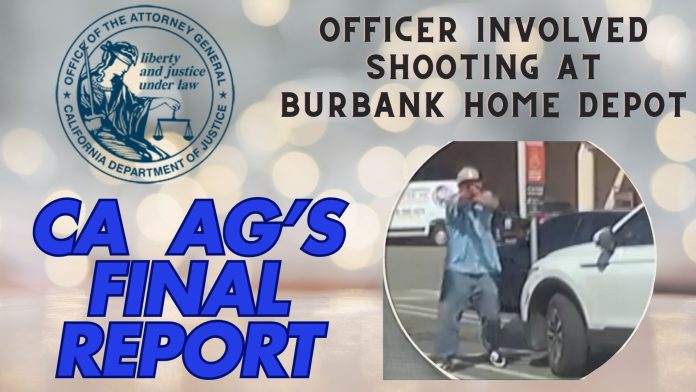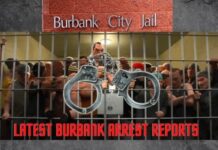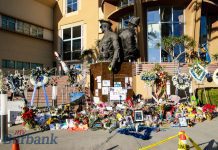The following is a summary of the California Department of Justice Report on the Investigation into the Death of Ruben Ramos on May 27, 2023. The full 31-page report can be found HERE, which was released on October 9, 2024.
Background – Assembly Bill 1506 (AB 1506)
On May 27, 2023, Ruben Ramos was fatally shot by officers of the Burbank Police Department (BPD) in a parking lot of Home Depot in Burbank, California. This officer-involved shooting was investigated under California’s Assembly Bill 1506 (AB 1506), which mandates the California Department of Justice (DOJ) to investigate any fatal officer-involved shootings of unarmed civilians. AB 1506, signed into law in 2020 and effective in 2021, was introduced to foster accountability and transparency in police actions, with the goal of rebuilding trust between law enforcement and the communities they serve. The DOJ’s investigation, which spanned months, involved a comprehensive review of the incident, including body-worn camera footage, eyewitness accounts, and forensic evidence. The report concludes with findings that no criminal charges will be brought against the officers involved.
Summary of the Incident
The incident began on the afternoon of May 27, 2023, at 3:50 pm, when Burbank Police received a 911 call from Ruben Ramos. In the call, Ramos claimed that his daughter had been abducted and murdered and that he was armed with a Beretta handgun in the parking lot of a Home Depot. Ramos further stated that he intended to start shooting people. BPD dispatched several officers to the scene, including Officers Jose Plascencia, Geovanny Fabian, and Peter Choi. Upon arrival, Officer Ricardo Perez, the first on the scene, positioned himself behind Ramos’ van and aimed his firearm at Ramos, who had exited his vehicle with his right hand concealed in his pocket. Other officers arrived soon after and also drew their weapons as Ramos refused to comply with repeated commands to show his hands. After a 14-minute standoff, during which Ramos pulled an object from his pocket and assumed a shooting stance, three officers opened fire, fatally wounding him.
“At 4:05:46 PM, Officers Plascencia, Choi and Fabian fired a total of 15 rounds at Mr. Ramos, striking him eight times. Officer Caldwell yelled, “Cease fire!,” and the shooting stopped. Mr. Ramos was approximately 28.8 feet away from Officer Plascencia and Officer Fabian and was approximately 34 feet away from Officer Choi at the time of the Officer Involved Shooting.” The object was later determined to be a black folding knife.
Officer Accounts and Statements
While Officers Plascencia, Fabian, and Choi did not give voluntary statements to the DOJ investigators, a number of the responding officers provided detailed accounts of the incident, shedding light on the tense and chaotic situation leading up to the shooting. These statements were crucial in piecing together the events as they unfolded.
Officer Ricardo Perez’s Statement
Officer Perez was the first officer to arrive on the scene at 3:55 PM. Perez observed Ramos sitting in the driver’s seat of a Toyota Sienna, speaking on his phone, and confirming his identity with dispatch. Knowing Ramos had claimed he was armed, Perez took cover behind his patrol car and drew his firearm, directing Ramos to show his hands and turn away from him. Ramos exited his vehicle but kept his right hand inside his pocket. Perez felt an immediate threat to public safety, especially considering the number of civilians in the crowded parking lot on that weekend afternoon.
Perez recalled that Ramos did not comply with his commands, and when backup arrived, including Officer Plascencia, the two officers continued issuing verbal commands. At one point, Ramos briefly raised his hands but soon dropped them and began pacing back and forth between his van and a white Volkswagen SUV parked nearby. Despite multiple attempts at de-escalation, including an offer from Officer Plascencia to help find Ramos’ daughter, Ramos remained non-compliant and increasingly agitated. Officer Perez recounted hearing a 40-millimeter less-lethal round being fired by Officer Maldonado, followed by gunfire, though he was unable to initially see who fired. Moments later, Ramos collapsed, and officers moved in to administer medical aid.
Officer Corey Salas’s Statement
Officer Salas arrived shortly after Officer Perez and positioned himself with Officer Maldonado to provide lethal coverage while Maldonado prepared a less-lethal 40-millimeter sponge launcher. Salas described Ramos as increasingly anxious and distrustful, constantly looking around as if he were searching for an opportunity to escape or possibly attack. He noted Ramos’ repeated refusal to show his hands despite over a dozen clear commands.
Salas was part of the team attempting to control the situation by providing both lethal and non-lethal options. He recalled Ramos taking a shooting stance after being struck by the less-lethal round and pulling an “L”-shaped black object from his pocket, which Salas believed to be a gun. Salas shouted “Gun!” and heard the gunfire that followed. He and other officers moved quickly to secure Ramos and provide first aid. Salas’ fear throughout the incident stemmed from the possibility that Ramos was concealing a firearm and that he might open fire on the officers or the civilians nearby.
Officer Manuel Maldonado’s Statement
Officer Maldonado’s role was critical, as he was assigned the task of deploying less-lethal force with the 40-millimeter sponge round launcher. Maldonado recounted that after arriving on the scene, he observed Ramos pacing near the Volkswagen, continuously reaching into his pocket and ignoring commands. He expressed concern that Ramos might have a firearm hidden in his pocket, given his refusal to show his hands. Maldonado attempted to fire a less-lethal sponge round at Ramos but missed the first shot due to positioning issues. He reloaded the launcher, took aim, and successfully fired, striking Ramos in the torso.
Maldonado described how Ramos winced in pain but immediately moved toward the officers, producing what appeared to be a firearm from his pocket. Maldonado distinctly recalled hearing the other officers open fire as Ramos assumed a shooting stance. Once the threat appeared to be neutralized, Maldonado assisted in rendering medical aid and later followed the ambulance to Holy Cross Trauma Center.
Officer Austin McKinney’s Statement
Officer McKinney provided support by obtaining a department-issued rifle and covering Ramos from a distance. He observed that Ramos appeared extremely agitated and noted that his refusal to comply with verbal commands heightened the tension among the officers. McKinney also expressed concern about the civilians in the area, noting that there were people near the store entrance and scattered throughout the parking lot. After the less-lethal round was deployed, McKinney recalled seeing Ramos take a shooting stance and hearing officers shout, “Gun!” before gunfire erupted. McKinney assisted in rendering medical aid once Ramos was down, describing the scene as chaotic but professionally handled by his fellow officers.
Officer Gutierrez’s Statement
Officer Ricardo Gutierrez had a clear line of sight on Ramos and observed him manipulating something in his right pocket while standing behind the Volkswagen SUV. Gutierrez testified that Ramos’ behavior indicated that he might be preparing to draw a weapon, as he continually reached into his pocket and paced nervously. Gutierrez noted that he heard Officer Maldonado fire the sponge round before Ramos pulled out the black object, which Gutierrez believed was a firearm. Like many of his colleagues, Gutierrez was convinced that Ramos posed a serious threat to the officers and civilians in the vicinity, justifying the use of lethal force.
Civilian Witness Accounts
Civilian witnesses provided varied perspectives on the incident, with most corroborating the officers’ statements about Ramos’ erratic behavior. Witness 1, an employee at Home Depot, described Ramos as being extremely aggressive and taking what appeared to be a shooting stance. Witness 5, a customer in the parking lot, observed Ramos holding up a black object that looked like a handgun, which prompted police gunfire. Other witnesses, including Witness 2, initially claimed that Ramos was unarmed and simply raising his hands. However, this account was later contradicted by video evidence from body-worn cameras and security footage, which showed Ramos holding an object in his hands.
Legal Analysis: Self-Defense and Imminent Threat
Under California law, a homicide may be justified if committed in self-defense or the defense of others. In this case, the DOJ’s investigation focused on whether the officers involved in the shooting acted reasonably in their belief that Ramos posed an imminent threat of death or serious bodily harm. Penal Code section 835a allows officers to use deadly force if they believe it is necessary to protect themselves or others from such a threat. The investigation revealed that the officers’ belief was both subjectively and objectively reasonable, given the totality of the circumstances: Ramos had threatened to shoot people, refused repeated commands, and pointed an object in a shooting stance toward the officers.
The DOJ concluded that Officers Plascencia, Fabian, and Choi reasonably believed that Ramos was about to shoot them, justifying their use of deadly force. Their actions were supported by the evidence, which showed that Ramos ignored numerous attempts at de-escalation and posed a clear danger.
Conclusion: No Criminal Charges
After reviewing the evidence, including officer statements, body-worn camera footage, and civilian witness accounts, the DOJ determined that there was insufficient evidence to support criminal charges against Officers Plascencia, Fabian, and Choi. The officers’ use of force was deemed lawful and consistent with both department policies and California law regarding self-defense.
Policy and Practice Recommendations
While the DOJ found that the officers’ actions were legally justified, it made two key recommendations for the Burbank Police Department:
- Weapon Discharge Protocols: The DOJ recommends that BPD update its policies to ensure that any unintentional or negligent weapon discharges, such as the accidental firing of Officer Caldwell’s 40-millimeter launcher, are properly documented and reviewed.
- Crisis Intervention Response: The DOJ advises expanding the availability of the Mental Health Evaluation Team (MHET) and providing additional training for officers on recognizing mental health crises and employing de-escalation techniques. Given that Ramos appeared to be experiencing a mental health crisis, this recommendation aims to prevent similar incidents in the future.
In summary, the death of Ruben Ramos was a tragic incident, but the DOJ’s investigation concluded that the officers involved acted within the bounds of the law. While no criminal charges will be filed, the recommendations provided are aimed at enhancing law enforcement practices to better handle such high-stress situations in the future.





















